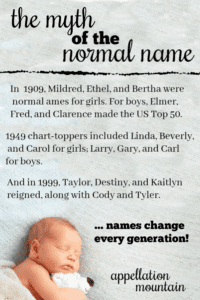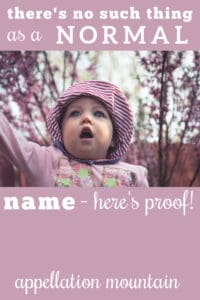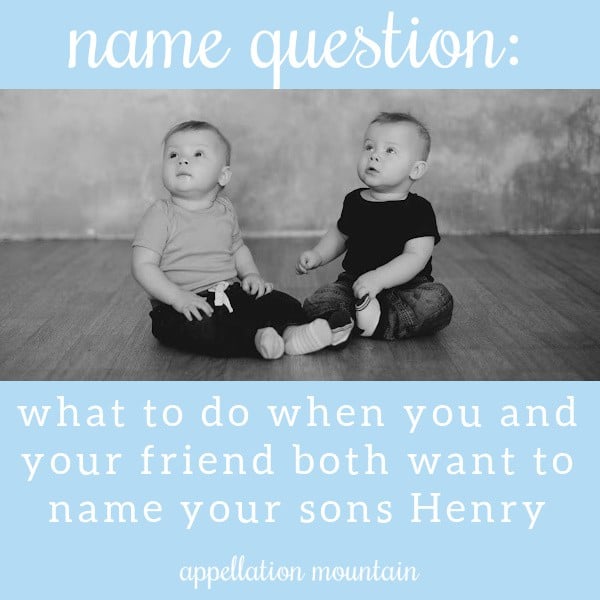
Visit nearly any baby name forum and it’s amazing how often you’ll hear variations on one comment:
Give your kid a normal name!
What’s even more dazzling is that this criticism comes in response to nearly any choice. Chart toppers like Harper and Hudson, classics like Edward and Eleanor.
I contend that there is no such thing as a normal name.
We think we know, of course. We can all list a few names that feel standard issue. But let’s hop into our time machine, because looking at the past? It proves my point.
Myth of the Normal Name: 1909
The definition of normal is regular; conforming to the common type. The best measure of this then, must be the Top 20 – or perhaps 50 – names, and thanks to the Social Security Administration, data on “normal” names is readily available.
Scan it for a few minutes, and I’m sure you’ll agree: just like hemlines have always varied, baby names have come in and out of vogue. Except the Top 50 are far from stable.
In 1909, the following names topped the charts:
- For girls, Mildred (#8), Ethel (#13), Gladys (#15), Gertrude (#25), Thelma (#26), Bertha (#29), and Myrtle (#43).
- For boys, Walter (#12), Willie (#13), Clarence (#19), Fred (#22), Roy (#28), Earl (#31), Elmer (#45), and Herman (#48).
Forward to 1929
No fair, you say? That’s too far back to find a true measure of normal? Let’s try 1929, then. After all, many more Americans are living into their 90s these days. You may very well know someone with one of these chart-toppers from 1929:
- For girls, Betty (#2), Doris (#6), Phyllis (#24), Norma (#25), and Geraldine (#43).
- For boys, Raymond (#15), Eugene (#20), Herbert (#25), Ralph (#26), Norman (#40) and Melvin (#49).
Skipping to 1949 and 1969
Even in 1949 – a year some of us can remember – plenty of the favorite names would feel out-of-place on a baby born today. Instead, these are the names of our aunts and uncles, our kindergarten teachers and dentists, the nice old couple a few houses down:
- For girls, Linda (#1), Carol (#8), Shirley (#18), Beverly (#31), Peggy (#38) and Connie (#43).
- For boys, Larry (#10), Gary (#12), Roger (#25), Bruce (#26), Terry (#28) and Carl (#43).
1969’s list – just over fifty years ago! – is packed with familiar names that would raise a few eyebrows today:
- For girls, Tammy (#9), Lori (#20), Dawn (#21), Tina (#22), Pamela (#24), and Rhonda (#44).
- For boys, Keith (#36), Troy (#42), and Rodney (#49).
By now, it should be clear – the parents naming their kids Keith and Dawn wouldn’t have considered Clarence and Bertha, even though they were similarly “normal” names from a generation or two earlier.
Circa 1985
Even the names of 1985 can feel like they belong to another era. We know – and like! – people with these names. But they’re firmly in the Mom-and-Dad-names category today. I mean, Bowling for Soup’s 1985 is nearly twenty years old.
- For girls, Ashley (#2), Heather (#8), Amber (#16), Brittany (#17), and Crystal (#21).
- For boys, Justin (#15), Kevin (#23), Kyle (#27), Dustin (#41), and Travis (#46).
My kid’s orthodontist is named Brandon, the #13 name in 1985. The cute boy names of the John Hughes generation grew up.
Party Like It’s 1999
If you’re reading this, odds are that you were alive in 1999. That means you’ll recognize these names. But none of them appear in the US Top 100 today:
- For girls, Taylor (#8 then, #217 now), Brianna (#14 then, #171 now), Destiny (#28 then, #391 now) and Kaitlyn (#33 then, #627 now).
- For boys, Tyler (#10 then, #164 now), Eric (#39 then, #229 now), and Cody (#45 then, #302 now).
Change is the Norm
Even a handful of 2009 names – Alexis, Alyssa, and Hannah for girls; Aiden, Jayden, and Landon for boys – have faded in use over the last decade.
The bottom line? The most commonly bestowed baby names in the US change constantly.
There’s a reason Phyllis, Shirley, and Troy dismiss Sebastian, Wyatt, and Elijah, Scarlett, Penelope, and Paisley as weird. If a kid in their generation had one of those names, it would stick out. But they’re just plain missing how much names change … and how quickly!
Are there classic names? Sure:
But even within those lists, some remain under-used today, like Peter or Frederick for boys, Theresa or Frances for girls.
But What About …
It’s clear that all names cycle in and out of favor. But aren’t there names that have always been outliers?
Sure. At least if we narrow our frame of reference to the US, I’d agree that’s there’s only one Oprah. (Well, she has a few namesakes. But Ms. Winfrey was first.) And Wolfgang has never been a crowd-pleaser. (Or it hasn’t yet. More than 100 boys have been named Wolfgang every year since 2015 – a new high.)
An unconventional spelling can render a familiar name confusing. But mostly, names cycle in out of popularity. Today’s wait-what choice could be tomorrow’s fast-rising favorite.
There’s no such thing as a normal name – and that’s a good thing.
First published on March 1, 2008, this post was revised substantially in 2013. It was updated on January 31, 2019 and again on July 5, 2023.





I totally agree with you i will name my kid normal name than a nice that is very hard to pronounce
I would love to applaud you for this!
I’ve said this for years. Just because something isn’t common or ‘normal’ to you- means that it is a weird or a unique name. People are far too quick to bran things as made up, weird or unique. What one must do is either give someone the benefit of the doubt or educate yourself on it before commenting. I would sometimes mention a name and say how it is said and that it was a popular name in my country -yet, people would still brand it as made up! ‘Shakes head and sighs’
This is one of the times when sometimes a person says a name is unique (and I know for a fact they live in a country and region where that name would not be foreign or weird) like Elise, it confuses me. The name just happens to have peaked a few years ago. lol It is a completely normal name that has been around for ages.
Oh well, I suppose region and your personal o exposure to certain names does influence what you view as ‘normal’.
A good example is the name Kai: in Japan it’s mainly a female name, whereas in the US, it’s mainly a male name. Also, in most English-speaking countries, the name Jan would be female, said, well- Jan. In SA, if it were on a male, it would be said YUN as it would be an Afrikaans name
Interesting observation. There are too many cultures at play in North America for our governments to place many limits on the names parents choose. In the Korean Sunday school class I teach we have two little Eugenes — one Eugene is a boy and the other is a girl. While it sounds odd to our ears, I have to remind myself that Eugene is actually a unisex name in Russia too.
I told my mother-in-law that if I ever had a little boy, I’d want to name him Adrian. She had a cow! She insisted that Adrian is a girl’s name. It isn’t — Adrianne is the feminine version of Adrian. I hoped spelling it for her would alleviate the misunderstanding, but she, a teacher, swears she’s had taught several little girls with that name and spelling.
Adrian is a fine traditional Irish male name. There are plenty of Irish-American girls with names like Murphey and Quin. That doesn’t make them “girl names”.
Luckily, my husband and I decided before we were married that we wouldn’t be having children.
You might find this map of popular baby names easier for browsing the SSA data. The map includes regions such as Alberta, Canada and Scotland that release every single name given so you can find some really rare names there. Like you said, the SSA data only extends to the top 1000 names unfortunately.